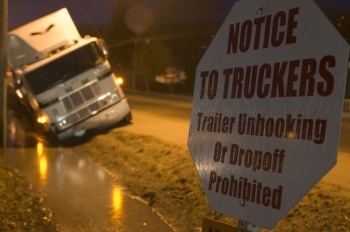Large truck fatalities spiked in 2012, according to NHTSA
WASHINGTON, D.C. – The U.S. DOT’s National Highway Traffic Safety Administration (NHTSA) recently released the 2012 Fatality Analysis Reporting System (FARS) data and the numbers don’t bode well for trucking safety.
Large-truck occupant fatalities increased for the third consecutive year (8.9 percent over 2011) and overall highway deaths increased to 33,561 in 2012, which is 1,082 more than 2011.
The American Trucking Associations (ATA) responded, saying the NHTSA numbers paint an “incomplete and misleading” picture of the U.S. trucking industry.
“Every fatality on our nation’s highways is a tragedy, and we all have an obligation to improve highway safety. Unfortunately, the data released by NHTSA is a misrepresentation of our industry’s improving safety record,” said ATA President and CEO Bill Graves. “When the public hears the term ‘large truck,’ they naturally think of the millions of large tractor-trailers that deliver their most essential goods. However, this data lumps those tractor-trailers in with millions of smaller, non-freight-hauling vehicles whose crash rates are higher than in the trucking industry. The federal government should not be so casual with its terminology and should provide further information and clarity to the public.”
The American Transportation Research Institute (ATRI) found earlier this year “noticeable differences in safety trends between different truck sizes, with medium-duty generally performing worse than heavy-duty trucks. In addition, the results indicated disparities between interstate and intrastate motor carriers.”
“ATA, along with the trucking industry, has a deep commitment to improving safety on our highways,” said ATA Chairman Phil Byrd, president of Bulldog Hiway Express. “That’s why ATA has pushed the federal government to limit truck speeds and require electronic logging devices for large trucks, as well as lobbying for improved enforcement of traffic rules around our large trucks so we can all arrive at our destination safely.”
“The highways are our workplace,” said Dale Williams, a Share the Road professional driver for Trimac Transportation. “So we all need to do our part to share the road safely. That means allowing for proper following distances and safe passing, as well as abiding by all posted speed limits and other rules of the road.”
U.S. Secretary of Transportation Anthony Foxx said the numbers reveal that the U.S. still has a lot of work to do when it comes to overall traffic safety.
“Highway deaths claim more than 30,000 lives each year and while we’ve made substantial progress over the past 50 years, it’s clear that we have much more work to do,” said Foxx. “As we look to the future, we must focus our efforts to tackle persistent and emerging issues that threaten the safety of motorists, cyclists and pedestrians across the nation.”
While Americans drove approximately the same amount of miles in 2012 as in the previous year, the new FARS data showed a 3.3 percent increase in fatalities from the previous year.
In addition to trucking, the report included other key 2012 statistics:
- Fatalities among pedestrians increased for the third consecutive year (6.4 percent increase over 2011). The data showed the large majority of pedestrian deaths occurred in urban areas, at non-intersections, at night and many involved alcohol.
- Motorcycle rider fatalities increased for the third consecutive year (7.1 percent increase over 2011). Ten times as many riders died not wearing a helmet in states without a universal helmet law than in states with such laws.
- Deaths in crashes involving drunk drivers increased 4.6 percent in 2012, taking 10,322 lives compared to 9,865 in 2011. The majority of those crashes involved drivers with a blood alcohol concentration (BAC) of .15 or higher – nearly double the legal limit.
- The number of people killed in distraction-affected crashes decreased slightly from 3,360 in 2011 to 3,328, while an estimated 421,000 people were injured, a 9 percent increase from the estimated 387,000 people injured in 2011. NHTSA is just beginning to identify distraction-related accidents, and is continuing work to improve the way it captures data to better quantify and identify potential trends in this area.
- Nighttime seat belt use continues to be a challenge. In nighttime crashes in 2012, almost two-thirds of the people that died were unrestrained.
“As a public health and safety agency, any increase in the number of deaths is cause for concern. While we’re seeing some unfortunate trends, we’re also seeing progress in some parts of the country,” said NHTSA Administrator David L. Strickland. “We will continue to work closely with our federal, state and local partners to change the way motorists behave on our roadways and build public awareness of key issues that have the potential to save many lives.”






